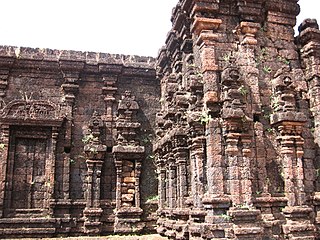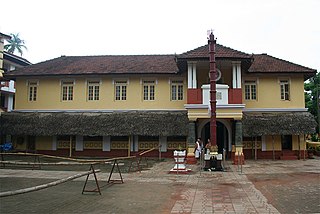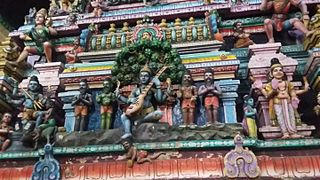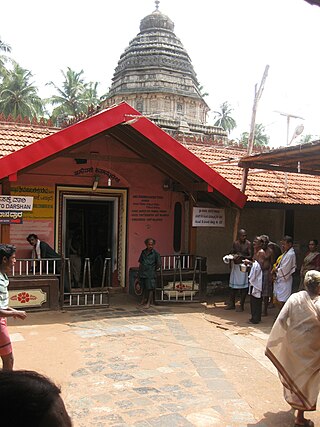Lord Bhavanishankar is Lord Shiva along with his consort Bhavani (Parvati). This is a form of Lord Shiva with his Shakti.
Lord Bhavanishankar is the patron deity of the Shri Saunsthan Gaudapadacharya Kavale Math.
Lord Bhavanishankar is Lord Shiva along with his consort Bhavani (Parvati). This is a form of Lord Shiva with his Shakti.
Lord Bhavanishankar is the patron deity of the Shri Saunsthan Gaudapadacharya Kavale Math.

Shiva, also known as Mahadeva or Hara, is one of the principal deities of Hinduism. He is the Supreme Being in Shaivism, one of the major traditions within Hinduism.

Nataraja, also known as Adalvallan, is a depiction of Shiva, one of the main deities in Hinduism, as the divine cosmic dancer. His dance is called the tandava. The pose and artwork are described in many Hindu texts such as the Tevaram and Thiruvasagam in Tamil and the Amshumadagama and Uttarakamika agama in Sanskrit and the Grantha texts. The dance murti featured in all major Hindu temples of Shaivism, and is a well-known sculptural symbol in India and popularly used as a symbol of Indian culture, as one of the finest illustrations of Hindu art. This form is also referred to as Kuththan, Sabesan, and Ambalavanan in various Tamil texts.

The Trimurti is the trinity of supreme divinity in Hinduism, in which the cosmic functions of creation, preservation, and destruction are personified as a triad of deities. Typically, the designations are that of Brahma the creator, Vishnu the preserver, and Shiva the destroyer. The Om symbol of Hinduism is considered to have an allusion to Trimurti, where the A, U, and M phonemes of the word are considered to indicate creation, preservation and destruction, adding up to represent Brahman. The Tridevi is the trinity of goddess consorts for the Trimurti.

Ardhanarishvara, is a form of the Hindu deity Shiva combined with his consort Parvati. Ardhanarishvara is depicted as half-male and half-female, equally split down the middle. The right half is usually the male Shiva, illustrating his traditional attributes.
Om Namah Shivaya is one of the most popular Hindu mantras and the most important mantra in Shaivism. Namah Shivaya means "O salutations to the auspicious one!", or "adoration to Lord Shiva". It is called Siva Panchakshara, or Shiva Panchakshara or simply Panchakshara meaning the "five-syllable" mantra and is dedicated to Shiva. This Mantra appears as 'Na' 'Ma' 'Śi' 'Vā' and 'Ya' in the Shri Rudram Chamakam which is a part of the Krishna Yajurveda and also in the Rudrashtadhyayi which is a part of the Shukla Yajurveda.

Omkareshwar is a Hindu temple dedicated to Shiva, located in Mandhata, nearby Khandwa city in Khandwa district of the Indian state of Madhya Pradesh. It is one of the 12 revered Jyotirlinga shrines of Shiva. It is on an island called Mandhata, near Khandwa city in the Narmada River at Khandwa district in Madhya Pradesh, India; the shape of the island is said to be like the Devanagari ॐ symbol.

The Rajarajeshwara temple is a Shiva temple located in Taliparamba in Kannur district of Kerala State of India. The temple is regarded as one of the existing 108 ancient Shiva Temples of ancient Kerala. It also has a prominent place amongst the numerous Shiva temples in South India. It had the tallest shikhara amongst the temples of its time. The Rajarajeshwara temple has a top of about 90 tonnes. If any problem is encountered in the other temples of South India, devotees seek a solution in this temple through a prashnam, a traditional method of astrological decision-making. The prashnam is conducted on a peedha outside the temple.

Mammiyur Mahadeva Temple is a popular Shiva temple situated in Guruvayoor, Thrissur district of Kerala, India. Every devotee who goes to Guruvayur Temple is supposed to go to Mammiyoor also, as the ritual goes. Only Hindus are allowed inside the temple premises. The temple is a part of the 108 famous Shiva temples in Kerala and one among the five Shiva temples around Guruvayoor. The main deity is Lord Shiva, who is installed in the concept of 'Uma Maheshwara' - His form with Goddess Parvathi on his left. There is a shrine for Lord Vishnu also here. The sub-deities are Lord Ganapathi, Lord Subrahmanya, Lord Ayyappan, Goddess Kali and Serpent deities. This temple is managed by Malabar Devaswom Board. Daily three poojas are conducted. Puzhakkara Chennas Mana is the hereditary Thanthri of this temple too. Shivaratri and Ashtami Rohini are the major festivals.

Shri Chitrapur Math is the central math for the Chitrapur Saraswat Brahmin sect. It has been located at Shirali in the Bhatkal Taluk in the North Kanara district of Karnataka since 1757. The other maths of the community are located in Gokarna, Karla, Mangalore and Mallapur. All of the maths have the insignia of the saffron flag.

Kedarnath Temple is a Hindu temple, one of the twelve jyotirlinga of Shiva. The temple is located on the Garhwal Himalayan range near the Mandakini river, in the state of Uttarakhand, India. Due to extreme weather conditions, the temple is open to the general public only between the months of April and November. During the winters, the vigraha (deity) of the temple is carried down to Ukhimath to be worshipped for the next six months. Kedarnath is seen as a homogeneous form of Shiva, the 'Lord of Kedarkhand', the historical name of the region.

Murdeshwar is a town in Uttara Kannada district in the state of Karnataka, India, It is famous for the world's second tallest Shiva statue, the town lies on the coast of the Laccadive Sea and is also famous for the Murudeshwara Temple. The town has a railway station on the Mangalore–Mumbai Konkan railway route.

Veeragase/Guggla is a dance form prevalent in the state of Karnataka, India. It is a vigorous dance based on Hindu mythology and involves very intense energy-sapping dance movements performed by Jangama. Veeragase is one of the dances demonstrated in the Dasara procession held in Mysore. This dance is performed during festivals and mainly in the Hindu months of Shravana and Karthika. It is performed at all important functions of Veerashaiva Lingayat household the veeragase artist's are called as puravanta in village side.
Swami Parijnanashram I, or Adi Parijnanashram, was the first guru and Mathadhipati, or head of a matha, of the Chitrapur Saraswat Brahmins. He is said to have been ordained by Lord Bhavanishankar in 1708 to guide the Chitrapur Saraswat community.

Ravishwarar Temple is a Hindu temple in Chennai, India. Built during the Chola period, the temple is dedicated to Shiva. It is located at Murthy Iyengar Street in the northern neighbourhood of Vyasarpadi.

Anandavalleeswaram Sri Mahadevar Temple in Kollam city is one of the ancient Hindu temples in Kerala, India. Lord Siva and Goddess Anandavally are the main deities of the temple. According to folklore, sage Parashurama has installed the idol of Lord Shiva. The temple is a part of the 108 famous Shiva temples in Kerala. It is located at Anandavalleeswaram, a major neighborhood of Kollam city, that comes to the west side of Kollam Collectorate.

Mazhuvannur Maha Siva Kshethram is an ancient Hindu Temple at Tharuvana in Wayanad district of the Indian state of Kerala. The presiding deity is Lord Shiva; other deities are Arayil Bhagavathy, Shree Durga, Nandhi, Lord Ayyappa and Lord Ganapathi. This temple is situated on the highest peak in the areas of Karingari, Paliyana, and Tharuvana. Daily poojas (prayers) were performed there from ancient times. Mazhuvannur Thekke Illam family members have been involved in leading pooja for many centuries.

Shri Gaudapadacharya Math, also known as Kavaḷē maṭha, located in Kavale, Ponda, Goa, is the oldest matha of the Smarthan Saraswat Brahman Samaj. It was founded by Gauḍapāda around 740 AD, whose student was Govinda Bhagavatpada, the guru of Adi Shankara, a highly influential figure in Hinduism. There is also a belief that Gauḍapāda himself established the Shri Gaudapadacharya matha when he lived in Gomantak (Goa). Thus, the matha came to be known as Shri Saunstan Gaudapadacharya matha. Unlike other mathas, Shri Gaudapadacharya matha is not a polemical center established to influence the faith of all Hindus, its jurisdiction is limited to only Dakshinatya Saraswat Brahmins. The Peetadhipathi "head monk" is Śrī Gauḍapadācārya. Smartist Goud Saraswat Brahman Samaj and Rajapur Saraswat Brahmin are its main disciples.

The Mahabaleshwar Temple, Gokarna is a 4th-century CE Hindu temple located in Gokarna, Uttara Kannada district, Karnataka state, India which is built in the classical Dravidian architectural style. It is a site of religious pilgrimage. The temple faces the Gokarna beach on the Arabian Sea. The temple deifies the Pranalinga also called Atmalinga or Shiva Linga In legend, it is said that the deity of the temple will bestow immense blessings to devotees, even to those who only glimpse it. Currently the administrative charge of the temple is with an Overseeing Committee under the Chairmanship of Justice BN Srikrishna, a Retired Justice of the Hon'ble Supreme Court of India. It is one of the 275 paadal petra sthalams expounded in the Tevaram, a sacred Tamil Shaivite text written during the 6th and 7th centuries by 63 saints called Nayanars.

Aasegobba Meesegobba is a 1990 Indian Kannada-language comedy film, directed by M. S. Rajashekar. The film stars Shiva Rajkumar, Lokesh and Sudha Rani, whilst Raghavendra Rajkumar appears in a cameo. Ambareesh and K. S. Ashwath are in guest roles. The music was composed by Upendra Kumar. The film is a remake of Amol Palekar's 1979 Hindi film Gol Maal. Actress Shruti debuted in this movie, playing Shiva Rajkumar's sister.

The Thirunakkara Mahadevar Temple situated in the heart of Kottayam is one of the 108 revered Shivalayas in central Kerala, India. The temple is about 500 years old and was built by the Raja of Thekkumkur. It also preserves a number of unique sculptures and murals of various Hindu deities. A common belief is that the idol of Shiva here is installed by Parashurama. The Thekkumkur royal family considered the idol as their paradevatha in the form of "Thirunakkara thevar"